History Buffs Embrace North Carolina’s CSS Neuse
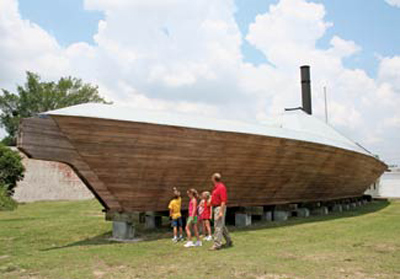
The Neuse II full scale replica is one block away from the interpretive center, Credit: CSS Neuse Civil War Interpretive Center
Historians knew where the remains were, their records showing that Union forces salvaged the engines, a boiler and the steam power plant. But the excavation of what some locals call the “gunboat,” “ronclad,” or “ram,” and salvaging the 141-foot hull and artifacts, became a formidable task with many setbacks. In hopes of floating the wreck, a cofferdam was built around it using empty 55-gallon drums lashed to the sides. This worked and soon the largely intact remains began to rise as mud and sand was pumped out. But heavy rains swelled the river, the cofferdam collapsed and the gunboat plunged back to the bottom. There were no funds left to continue the project.
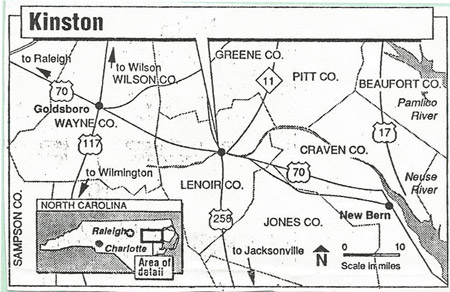
Map showing Kinstson, N.C. Credit: N.C,. Dept. of Natural Resources
In 1969, most of the hull and a deluge of naval and personal artifacts had been recovered and displayed at the (Governor) Richard Caswell State Historic Site located near the river. But when Hurricanes Fran in 1996 and Floyd in 1999 reminded everyone that their cherished exhibit was on a flood plain, the Department of Cultural Resources made a wise decision to move. That’s when the interpretative center, a state of the art museum housed in a climate controlled environment on Queen Street, rejuvenated downtown Kinston. As visitors tour the center, its exhibits become time capsules that return them to another era. Displays begin on the first floor encircling the centrally located remains of the CSS Neuse, then flow counterclockwise to other exhibits.
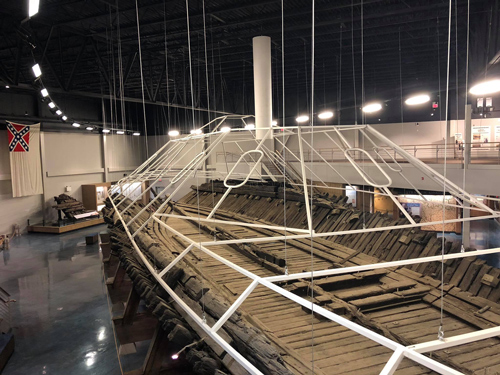
Hull of CSS Neuse with framework that depicts casemate, Credit: CSS Neuse Civil War Interpretive Center
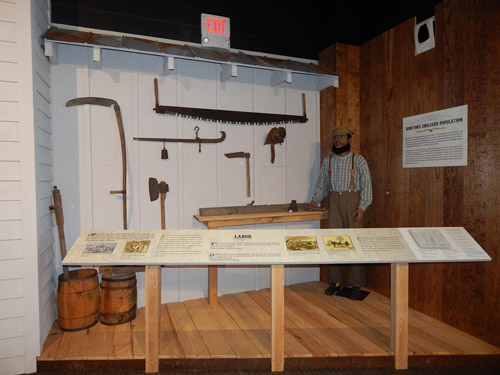
Building and farming trades were vital in Kinston during the Civil War, Credit: CSS Neuse Civil War Interpretive Center
Site Manager Matt Young says visitors can get a good look at the ship’s hull from the viewing platform in the mezzanine. “Half of the mezzanine has our popular home front exhibit of Kinston, the Lenoir County seat,” Young says, “and we’re raising funds to finish the other half which will cover North Carolina’s military operations during the war.”
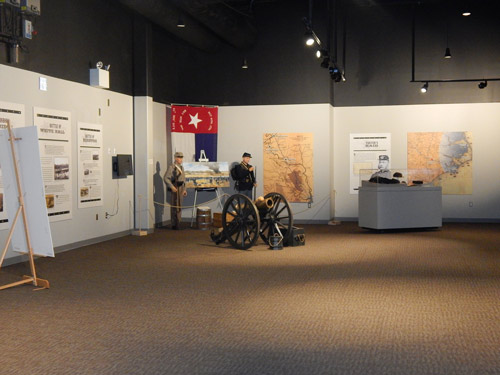
Civil War exhibits take visitors back in time. Credit: CSS Neuse Civil War Interpretive Center
In 1863, after a shortage of iron delayed construction, the gunboat was floated down river from Whitehall (now Seven Springs) to Kinston, where it was fitted with engines, cannons, stores and a locomotive boiler. In the spring of 1864, it was returned to Kinston where Confederate land forces were preparing for a Union attack. In March, 1865, Union troops advanced along the river to within five miles of Kinston and appeared ready to take the city. Commander Joseph Price, realizing he was trapped, followed orders sent from General Braxton Bragg, placed a charge in the boat’s bow and set fire to his vessel. The ensuing explosion blew a hole in the port side and the heavy iron behemoth settled to the shallow water bottom. Northern forces overran Kinston and the boat remained on the river bottom for nearly a century. The CSS Neuse never went to war nor accomplished any heroic feats, yet it remains one of Kinson’s top attractions. It draws wide appeal, not just from Civil War enthusiasts but history buffs as well…especially those who relish the interpretation of human events in the Tar Heel State.
Author: Ellsworth Boyd
Ellsworth Boyd, Professor Emeritus, College of Education, Towson University, Towson, Maryland, pursues an avocation of diving and writing. He has published articles and photo’s in every major dive magazine in the US., Canada, and half a dozen foreign countries. An authority on shipwrecks, Ellsworth has received thousands of letters and e-mails from divers throughout the world who responded to his Wreck Facts column in Sport Diver Magazine. When he’s not writing, or diving, Ellsworth appears as a featured speaker at maritime symposiums in Los Angeles, Houston, Chicago, Ft. Lauderdale, New York and Philadelphia. “Romance & Mystery: Sunken Treasures of the Lost Galleons,” is one of his most popular talks. A pioneer in the sport, Ellsworth was inducted into the International Legends of Diving in 2013.
4 Comments
Submit a Comment
All Rights Reserved © | National Underwater and Marine Agency
All Rights Reserved © | National Underwater and Marine Agency
Web Design by Floyd Dog Design
Web Design by Floyd Dog Design

Excellent article, I must visit that and the Hunley sometime.
Yes, Capt.Ethan, try to get down there and see the Hunley and Neuse. I’ve seen the Hunley and will try to see the Neuse on my next trip south. Hope you’ve captained some good trips this season. Cheers, E.
Stop in Plymouth, N.C. on your way down & visit the CSS Albemarle!
portoplymouthmuseum.org
Thanks! Yes, this is an outstanding small war museum honoring the Battle of Plymouth, Plymouth, NC. The replica of the CSS Albarmarle is docked there and sails once a year during the Living History Celebration held on the last weekend of April. The history of the original Albamarle’s battle with the USS Sassacus is a highlight in the museum.